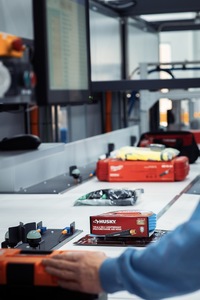

|
Edward Lowton
Editor |


|
| Home> | Handling and Storing | >Packaging | >It's time to pack smarter |
It's time to pack smarter
20 May 2025
The rise in Employer National Insurance is but one factor set to impact ecommerce packaging. So what can be done to alleviate the pain, asks Jo Bradley

IF DISTRIBUTION and fulfilment operations ever did benefit from ‘cheap’ labour, a series of recent Government announcements has ensured that era is well and truly over. Controlling labour costs through automation is no longer optional - it’s a question of business survival.
In short order, the Government has raised the minimum wage by significantly more than inflation to £12.21 an hour for workers over the age of 21, Employer National Insurance contributions are rising from 13.8% to 15%, and in a further twist, this will now apply to workers on annualised pay of as little as £5,000 rather than the previous £9,100.
That last provision in particular hits the many fulfilment operations that are heavily dependent on seasonal or casual employees to cope with peak in activity.
Navigating New Labour Challenges with Automation
The response must lie with automation, but few businesses can afford the investment or business disruption required to go ‘full Amazon’ across activities such as retrieval, order picking and internal transport. These tend to be heavily interdependent, and ‘step by step’ approaches can be problematic.
One area that for many fulfilment operations can be treated as a standalone project, with the prospect of significant reductions in labour requirement, and thus an attractively quick ROI, is that of packing and labelling goods into cartons for transport. Ecommerce operations, in particular, can stand to reap big rewards in terms of savings in labour and material costs. Our repeated customer experience is that using ‘fit to size’ automation to fold and build boxes around consignments - even of mixed and varied goods - followed by auto sealing, weighing and labelling, can see one or two operators replacing as many as twenty manual packing benches.
Adapting to a Changing Landscape
But in selecting automated packaging technology businesses shouldn’t focus on labour costs alone. There are other cost pressures looming, with the revised Extended Producer Responsibility regulations are about to come into effect. These are complex, involving fees and credit notes and a significant administrative burden, but at heart they involve a levy on the use of packaging materials. Precise rates are yet to be fixed but the Government’s current mid-point estimates are around £190 per tonne for paper and card, and a deliberatively punitive £425 per tonne on plastic packaging materials.
This is intended to encourage firms to reduce the use of packaging materials. Sparck’s ‘fit-to-size’ automated packaging systems not only minimise the use of card used, by tailor-making a box for each individual order, but can also eliminate the need for void fillers which are often plastic based.
Those savings can go straight to the bottom line. There are also other less easily quantifiable but nonetheless real benefits. Well-fitting boxes reduce the incidence of shock or crush damage in transit. They economise on the use of transport space, which can also yield cost savings, on fuel obviously, but also in warehouse labour as there may be fewer roll cages to push around.
Jo Bradley is business development manager at Sparck Technologies
For more information:
Tel: +31 512 589 300



















